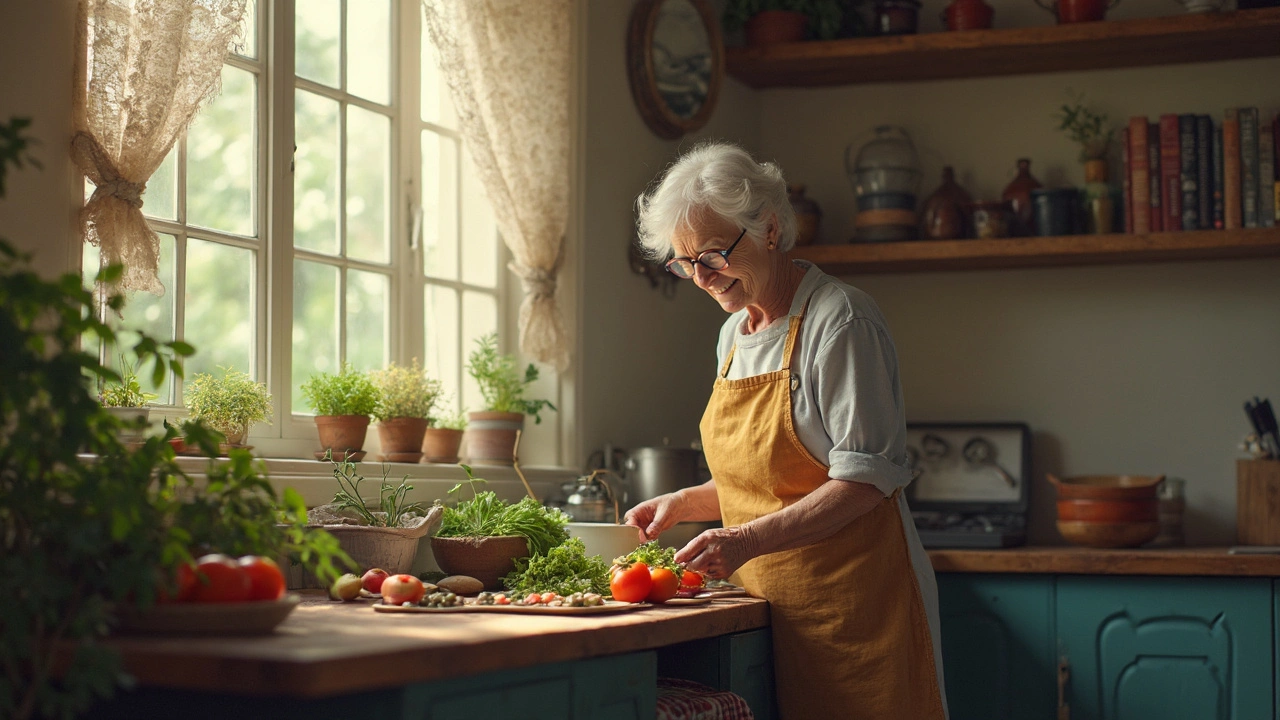Gout is that unwelcome guest that loves to crash the party, especially among the elderly. It's not just a little irritation; those burning, swollen joints can be downright debilitating. But here's the good news: you can take steps to keep it at bay or at least make life a little easier when it does show up. So, what's the deal with gout? Well, it's a type of arthritis, and it happens when uric acid builds up in the body, forming crystals in the joints. This usually hits the big toe but can strike elsewhere too.
For our older friends, gout can mess with mobility, and let's face it, no one wants to hobble around on a walker if they can help it. So, preventing flare-ups is crucial. One of the biggies is diet. Foods like red meat, shellfish, and alcohol are high in purines, which your body breaks down into uric acid. Cutting back on these can really help.
Understanding Gout
Let’s unravel what gout is all about. Imagine your joints having their own little protest—complete with swelling and pain. That’s gout. It's a kind of arthritis, and the pain can be quite intense. The culprit? A substance called uric acid. Normally, your body handles uric acid just fine. But sometimes, it decides to hang around, forming sharp crystals in the joints.
What Causes Gout?
It all boils down to too much uric acid in your blood. This can happen for a bunch of reasons. Firstly, eating foods high in purines—like red meat, seafood, and alcoholic drinks—can spike uric acid levels. Your kidneys also play a part. If they're not filtering uric acid efficiently, voilà, you have an excess.
Why Are the Elderly More Affected?
Gout seems to have a special affection for the elderly. Why? Part of it is because as we age, kidneys may not be as effective at filtering uric acid. Plus, other health conditions common in older adults, like high blood pressure or diabetes, can increase the risk. Medications for these conditions might also contribute, creating a perfect storm for a gout flare-up.
Common Symptoms
- Sudden, severe pain in a joint—usually the big toe
- Swelling and redness
- Feeling warm in the affected area
- Reduced range of motion
Recognizing these symptoms early on is key. Catching a flare-up before it peaks can make all the difference, allowing for quicker relief and less interference with daily life.
Prevention Tips
Kicking gout to the curb isn't just a dream—it's doable! The secret is in the everyday choices we make. So, if you or your loved ones are in the senior circle, these tips are right on the money.
Watch What You Eat
A big piece of the prevention pie is diet, folks. You might love that steak dinner or seafood platter, but beware—they're high in purines, which can boost uric acid levels. Instead, focus on gout-friendly foods like fruits, vegetables, and whole grains. Cherries, in particular, have shown some promise in reducing flare-ups.
Keep Moving
Staying active is key, even if it's just a daily walk around the block. Regular exercise helps with weight control, and that's a biggie since excess weight is a known trigger for gout attacks. Plus, it keeps the joints moving and grooving.
Stay Hydrated
Drink that water like it's going out of style! Staying well-hydrated can prevent uric acid from crystallizing. Aim for about eight glasses a day, but if you're finding water a snore, mix it up with herbal teas or water-rich foods.
Limit Alcohol
Not to be a buzzkill, but alcohol, especially beer, can lead to painful episodes. It messes with your body's ability to eliminate uric acid. So, keeping those drinks to a minimum can make a significant difference in how often elderly people experience attacks.
Avoid Crash Diets
Rapid weight loss can send your uric acid levels into overdrive. If shedding some pounds is on the agenda, go slow and steady. It's not just more sustainable—it's better for keeping those dreaded symptoms at bay.
Medication Matters
For some, especially older adults, lifestyle shifts might not be enough. If attacks persist, it might be time to chat with a doctor about medications that lower uric acid levels. This is especially important if there's a family history of gout.
| Step | Action |
|---|---|
| 1 | Balance your diet with low-purine foods. |
| 2 | Exercise regularly to manage weight. |
| 3 | Keep well-hydrated to prevent uric acid build-up. |
| 4 | Limit alcohol intake. |
| 5 | Avoid aggressive weight-loss programs. |
| 6 | Consult a doctor for medication if needed. |

Treatment Options
Treating gout in the elderly can be a game-changer when it comes to managing pain and swelling. It's all about nipping those flare-ups in the bud. Let's check out the various ways to tackle this.
Medications
The first line of defense is often medication. Nonsteroidal anti-inflammatory drugs (NSAIDs) like ibuprofen can help reduce pain and inflammation. Just remember, these aren't for everyone, especially if stomach issues or kidney problems are in the mix.
Corticosteroids are another option. These can be taken orally or injected directly into the joint. They act pretty fast against inflammation. A doctor might suggest them if NSAIDs aren't cutting it.
Then we have colchicine. It's handy for quick relief during an attack. But, watch out for side effects like nausea and diarrhea.
Urate-Lowering Therapy
For long-term control, urate-lowering therapies (ULTs) are often recommended. Allopurinol and febuxostat are two drugs in this category that help reduce uric acid levels. They might not stop an immediate attack, but they can prevent future ones. It's a marathon, not a sprint.
Combining Treatments
Sometimes, a combo of approaches works best. Starting treatment with NSAIDs during a flare-up, then moving on to ULTs once things calm down can be effective. Everyone's different, and finding the right mix can make all the difference.
While medications are crucial, touching base with your healthcare provider regularly is essential. They'll tweak doses, switch medications if needed, and keep an eye on potential side effects, especially since older folks might react differently.
Alternative Therapies
Some folks find relief with alternative therapies. Acupuncture or herbal supplements may offer some benefits, but always chat with your doc before diving in. The last thing you want is something that messes with your regular treatments or other meds.
Lifestyle Changes
When it comes to tackling gout, making some smart lifestyle changes can make a massive difference. Think of it as a team effort between you and healthier habits. Ready to dive in?
Stay Hydrated
Your kidneys are like little powerhouses that filter out toxins, including uric acid. Drinking plenty of water helps them do their job better. Aim for about 8 to 12 cups a day. That's a lot, but your elderly body will thank you for it!
Diet Tweaks
As we mentioned before, cutting back on purine-rich foods is key. But here's what you can add: cherries, which some studies show might reduce uric acid levels. Toss in a few more fruits and veggies, and don't be shy with low-fat dairy. They can all be part of your secret weapon against gout.
Get Moving
Being active is great for joints. Low-impact exercises like swimming or walking work wonders and are easy on the body. Aim for at least 30 minutes most days of the week. It's about keeping those joints moving and reducing gout flare-ups.
Manage Stress
Stress and inflammation aren't friendly. Practicing mindfulness, yoga, or just taking time to relax can help keep those stress levels in check. You'll feel better overall, with a reduced chance of triggering gout.
Keep an Eye on Those Numbers
Keeping track of your uric acid levels is crucial. Regular check-ups with your doctor should be a part of your routine. They might recommend medications if your levels are through the roof, but a lot can be managed with these lifestyle swaps.
Here's a quick look at some ideal uric acid levels:
| Age Group | Ideal Uric Acid Range (mg/dL) |
|---|---|
| Under 60 | 3.5 - 7.2 |
| 60 and above | 2.5 - 7.5 |
Adopting these lifestyle changes not only tackles gout directly but also brings a wealth of health benefits you can't ignore. A little bit here, a little bit there, and pretty soon, you've built some serious defense against those pesky gout flare-ups.



i just learned my mom had a gout flare-up last week and she cried because she couldn't walk to the kitchen without help. i had no idea it was this bad. thanks for explaining it so clearly. i’m gonna print this out and take it to her next visit.
Let me be real for a second-this article is nice but it’s not enough. Nobody talks about how doctors just throw pills at elderly patients and call it a day. My uncle got prescribed colchicine and ended up in the ER with diarrhea for three days. No one warned him. No one followed up. This isn’t prevention-it’s neglect wrapped in bullet points.
Stop eating meat stop drinking beer drink water walk every day thats it no magic pills no fancy diets. Your body is not broken its just lazy. Gout is a choice and so is healing. Start today or suffer forever.
i’ve been reading this while sipping chamomile tea and honestly i feel seen. i’m 72 and i’ve had two gout attacks in the last year. i didn’t know cherries helped until now. i’m gonna start eating them every morning. small steps, right? thanks for not making me feel guilty about my past steak dinners.
From India, I can tell you-our elders often eat a lot of lentils and dairy, which are actually gout-friendly. Many don’t realize that paneer or dal are safer than red meat. Also, turmeric tea is a traditional remedy here. Not a cure, but it helps with inflammation. Worth a try if your doctor says it’s safe.
Uric acid levels above 7.5 mg/dL in seniors? That’s a red flag. Most labs still use the same range for everyone, but research shows older adults metabolize uric acid differently. Ask your doctor for a 24-hour urine test-not just a blood draw. It’s more accurate. Also, avoid high-fructose corn syrup. It’s in everything now, even ‘healthy’ juices.
gout is just nature's way of punishing people who eat like pigs and drink like fish. if you're old enough to have gout, you're old enough to know better. stop blaming your kidneys. stop blaming meds. stop blaming the system. it's your fault. fix it.
you know what’s really causing gout? Big Pharma and the meat industry. They want you sick so they can sell you drugs and steaks. They even made uric acid tests expensive so you can’t monitor yourself. And don’t get me started on how the FDA ignores natural remedies. This article is propaganda. 🤫💊🥩
as someone who grew up in a household where ‘treat yourself’ meant a 2-pound ribeye and a six-pack on Sunday, i’m both horrified and proud of how far we’ve come. my grandma used to say, ‘if you can’t dance, you’re not living’-and now she walks 3 miles a day with a cane, eats cherries like candy, and refuses to touch beer. she’s 84. and she’s winning. so yes, change is possible. it’s messy. it’s slow. but it’s real. and it’s beautiful. 🌸
hydration? really? that’s your big tip? wow.
My dad’s been on allopurinol for five years now. He takes it every morning with his oatmeal and coffee. He doesn’t drink alcohol anymore, walks with his dog every day, and eats a ton of low-fat yogurt. He’s had zero flares since. It’s not glamorous, but consistency beats intensity every time. Also, if you’re on meds, never skip your kidney check-ups. I learned that the hard way.
everything is a cycle. pain leads to awareness. awareness leads to change. change leads to peace. but only if you’re ready to let go. 🌿
my aunt says she doesn’t care if she gets gout-she’d rather taste the steak than live pain-free. i don’t agree with her… but i get it. sometimes the joy is in the thing that hurts you. maybe healing isn’t always about giving up. maybe it’s about choosing what matters most.